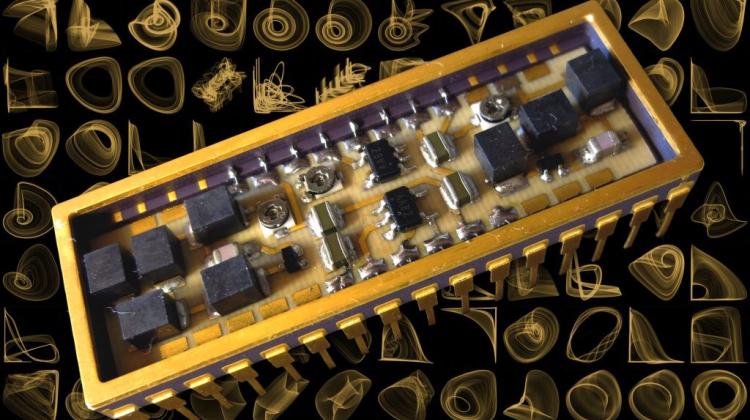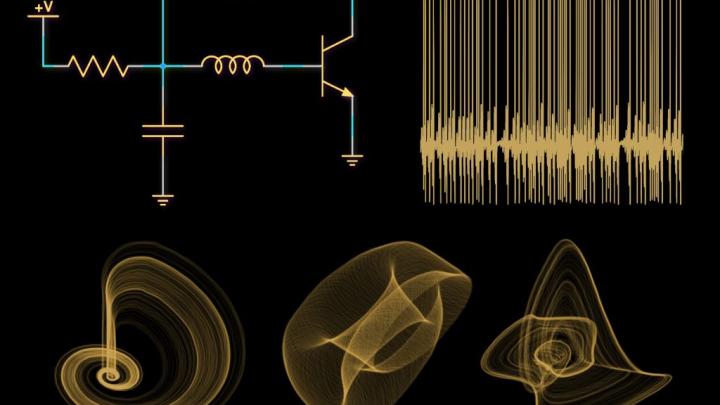Chaos rules even simple electronics

It turns out that many simple electronic systems, composed of just a few elements, can behave chaotically - in an extremely complicated, practically unpredictable manner - show physicists from Kraków.
Physicists from the Institute of Nuclear Physics of the Polish Academy of Sciences in Kraków have discovered, studied and described dozens of new, unusual systems of this type. Interestingly, one of the circuits generates voltage pulses very similar to those produced by neurons, but it does thousands of times faster. The Institute of Nuclear Physics PAS informed about their research in a release sent to PAP.
Just a few transistors, resistors, capacitors and coils are enough to build electronic circuits that behave in a virtually unpredictable way. Even in such simple systems, chaotic, complex oscillations turn out to be not an exception, but the norm, demonstrated scientists from the Institute of Nuclear Physics of the Polish Academy of Sciences in Kraków.
In the paper published in the journal Chaos (http://dx.doi.org/10.1063/1.4994815), they presented 49 new, non-typical chaotic electronic oscillators - not designed, but discovered with computer simulations. Chaotic electronic oscillators had been known before. So far, however, it seemed that there were only a few variations, and their construction would require some effort and certain complexity of the system.
"Electronics is usually associated with devices that work precisely and always according to expectations. Our research paints a completely different picture. Chaos is ubiquitous already in electronic circuits containing only one or two transistors! The predictable and always the same reactions of electronic devices that we all use every day do not reflect the nature of electronics, but the efforts of designers" - said the first author of the publication, Dr. Ludovico Minati (Institute of Nuclear Physics PAS).
Chaos is commonly understood as lack of order. The Institute of Nuclear Physics PAS representatives note that in physics this concept works a little differently: a system is considered to behave chaotically when even very small changes in input parameters result in large changes in output. Because various fluctuations are natural in the world, in practice chaotic systems show enormous wealth of behaviours - so great that precise prediction of their reactions is very difficult, and often impossible. A system may seem to behave quite randomly, even though in fact its evolution follows a certain complicated pattern.
Chaotic behaviour is so complex that today we do not have methods to effectively design electronic circuits of this type. Physicists from the Institute of Nuclear Physics PAS approached the problem differently. Instead of constructing chaotic oscillators, they decided to discover them.
The simulations were run on Cray XD1 supercomputer. "Our search was blind, in a gigantic area of 2 to the 85th power possible combinations. During the simulations we analysed about two million circuits, an extremely small part of the available area. In this group, approx. 2,500 systems have shown interesting behaviour" - said Dr. Minati.
The 100 most interesting systems were physically built and tested in a lab. In order to improve the quality of the signals generated during the tests, the delicate "tuning" of the component parameters was often performed. Ultimately, the number of interesting systems was reduced to 49.
The smallest chaotic oscillator consisted of one transistor, one capacitor, one resistor and two coils. Most of the discovered circuits exhibited non-trivial, chaotic behaviour with sometimes astonishing scale of complexity. This complexity can be visualized using special graphs - attractors, geometrically reflecting the nature of system activity changes in time.
Particularly interesting was one of the discovered oscillators, which generated voltage jumps similar to excitations typical for ... neurons. The similarity of impulses was striking, but not complete.
"Our artificial neuron analogue has proven to be much faster than its biological counterpart: pulses were produced thousands of times more often" - said Dr. Minati. He noted that the mechanism did not meet certain conditions that neurons meet. The device can not be called a superneuron.
Physicists from Kraków have also demonstrated that as a result of connecting the discovered circuits in pairs, behaviours of even greater complexity appear. Coupled circuits in some situations worked perfectly synchronously, like musicians playing in unison, in other situations one of the circuits took the role of leader, in other the mutual connection of the oscillators was so complex that it was revealed only after careful statistical analysis.
In order to accelerate the development of research into electronic systems that simulate the behaviour of the human brain, the schematic diagrams of all circuits discovered by physicists from the Institute of Nuclear Physics PAS have been made public. (ftp://ftp.aip.org/epaps/chaos/E-CHAOEH-27-012707). (PAP)
author: Ludwika Tomala
PAP - Science and Scholarship in Poland
lt/ agt/ kap/
tr. RL
Przed dodaniem komentarza prosimy o zapoznanie z Regulaminem forum serwisu Nauka w Polsce.
















